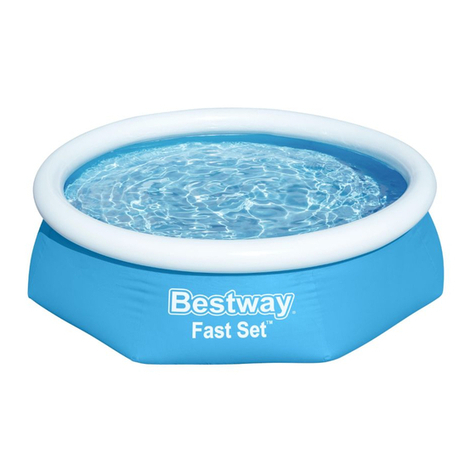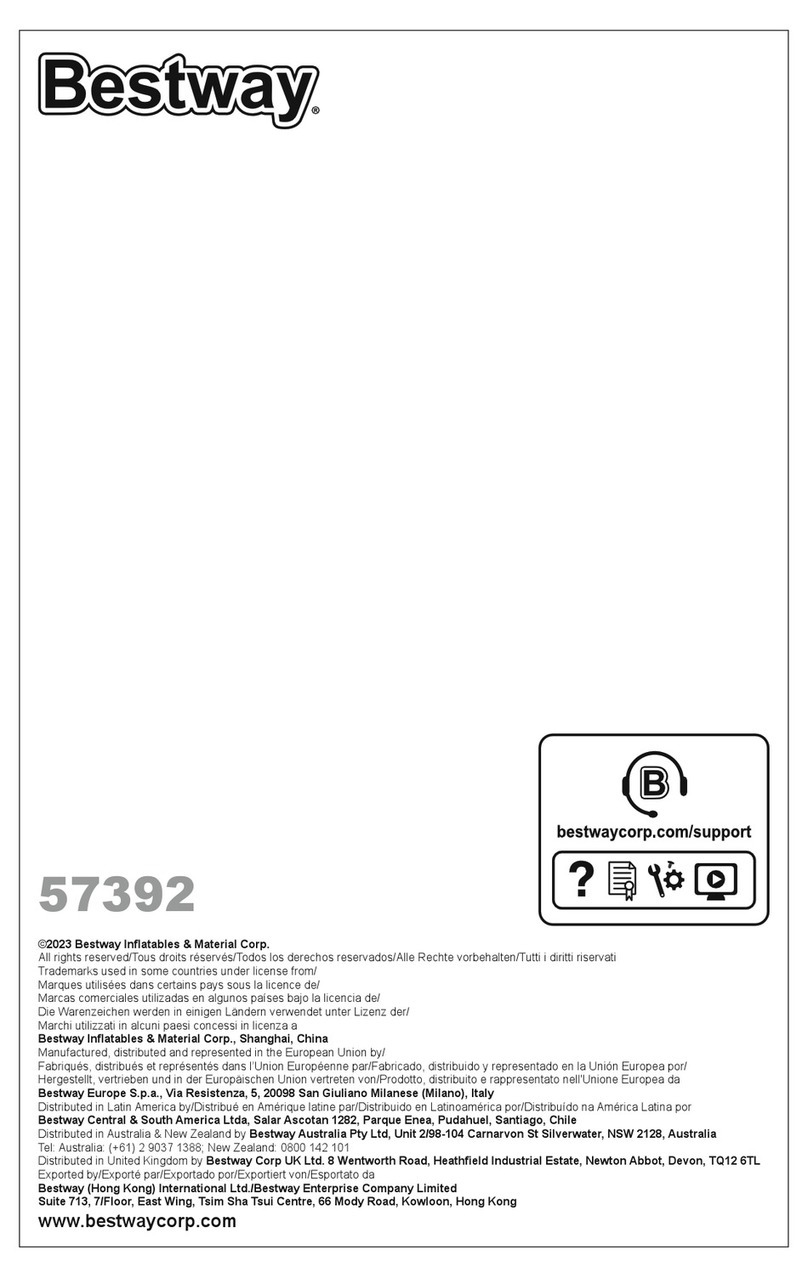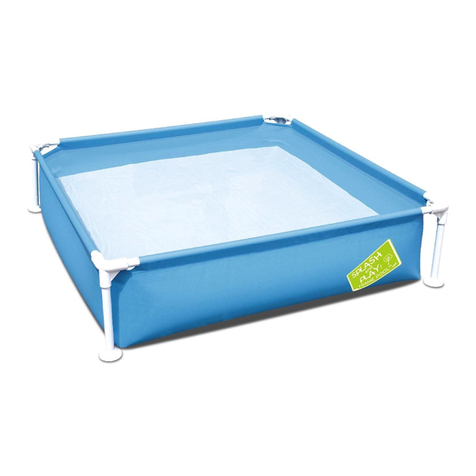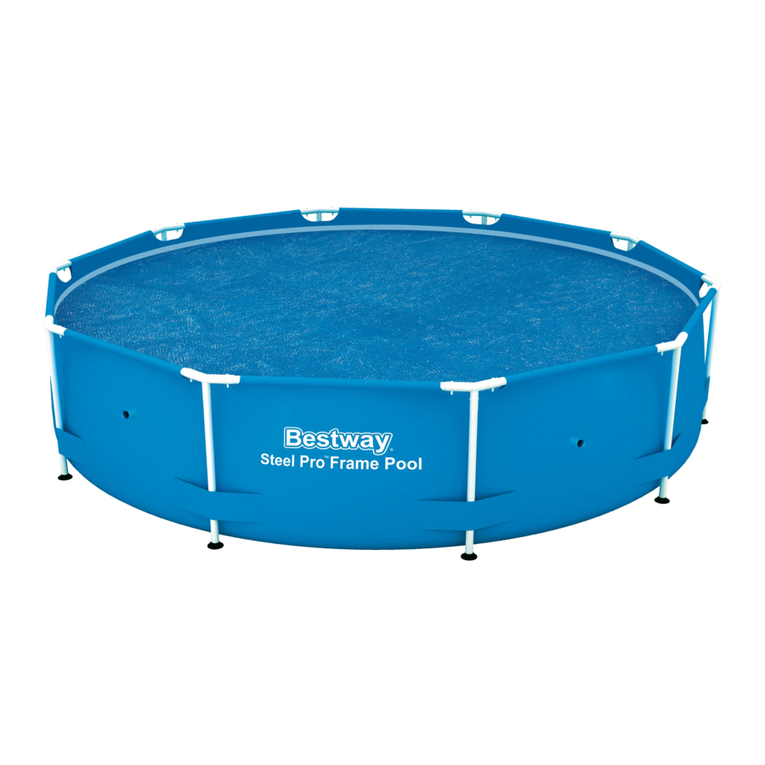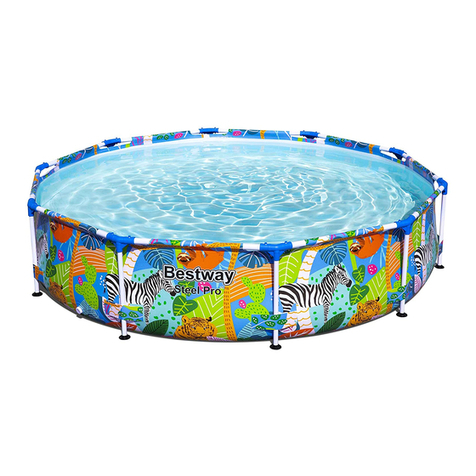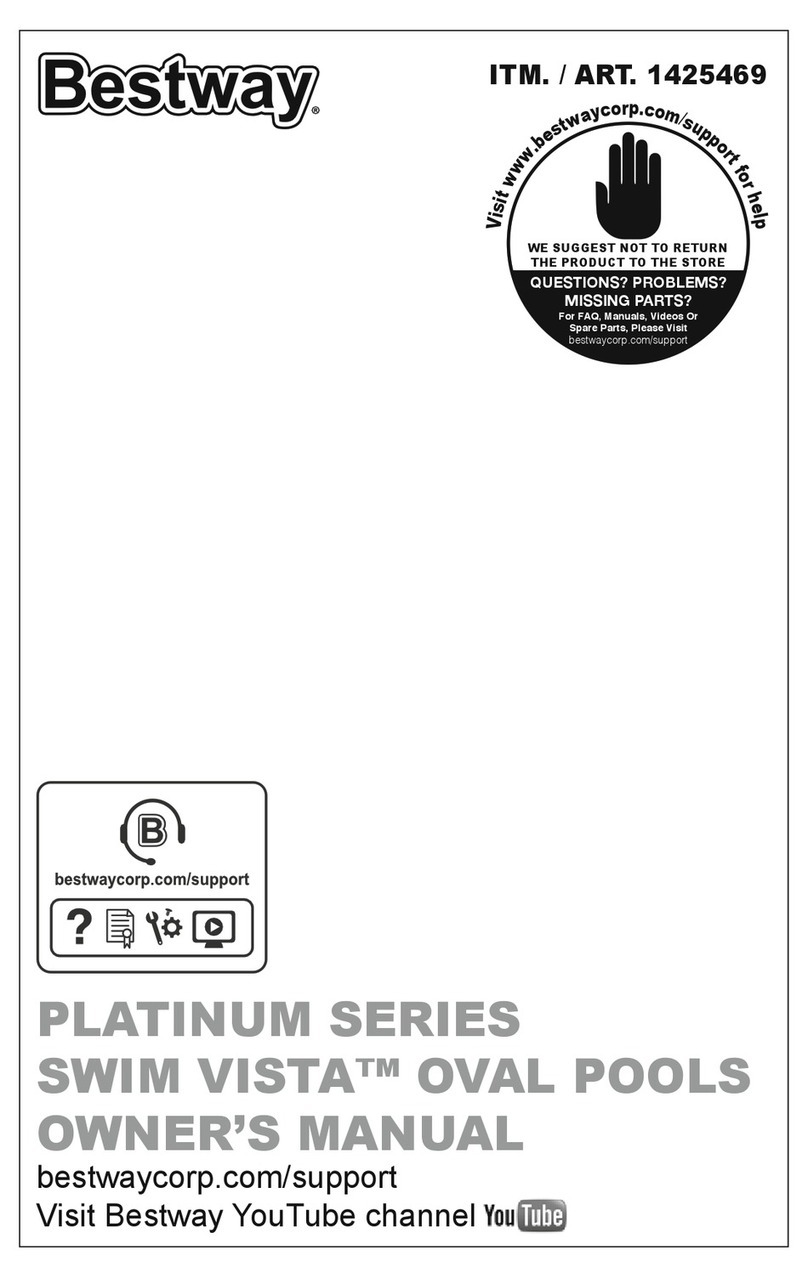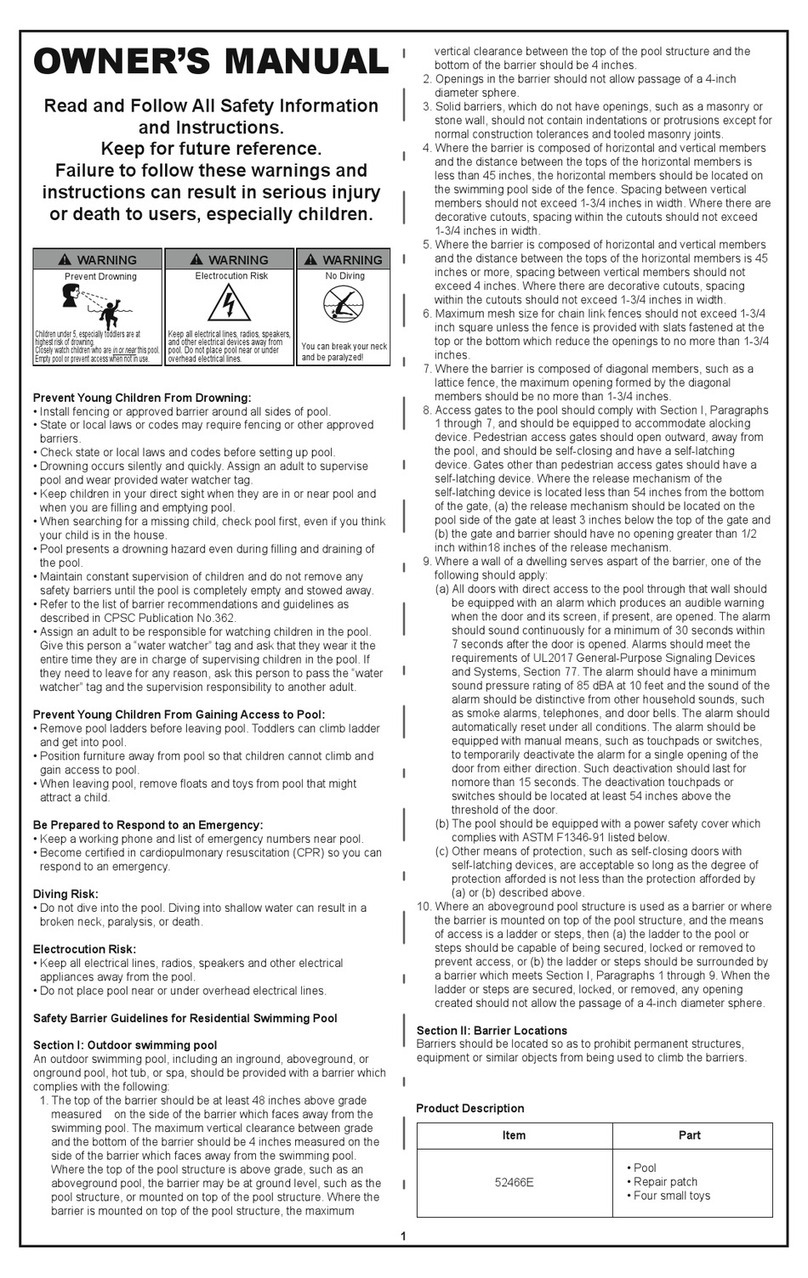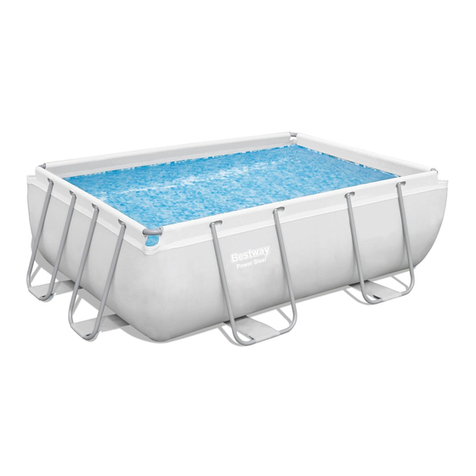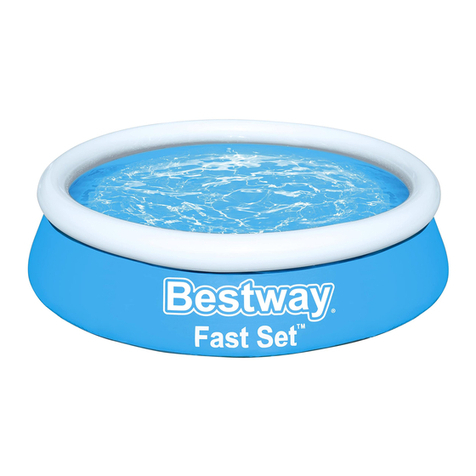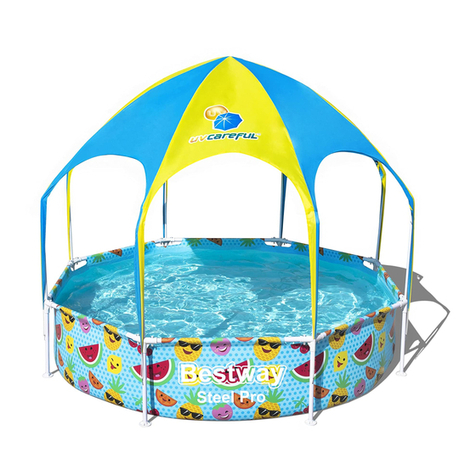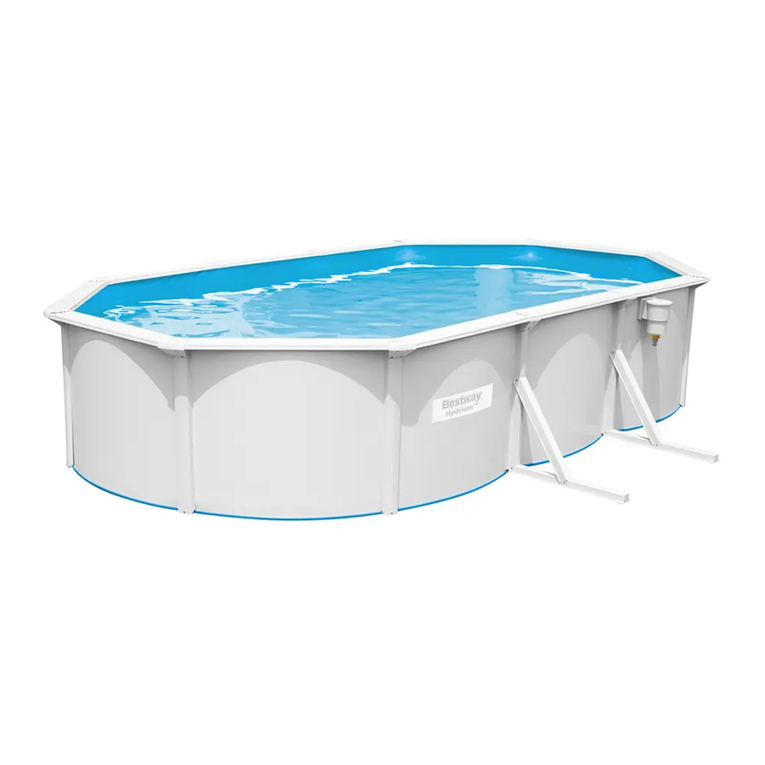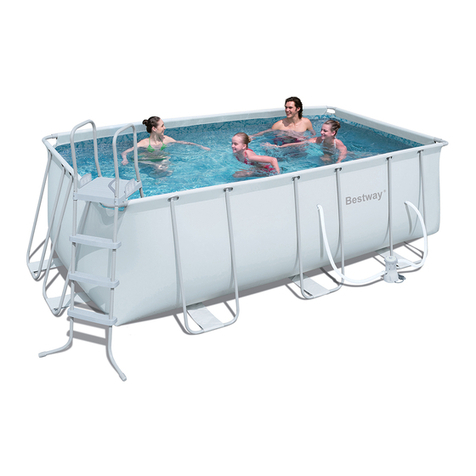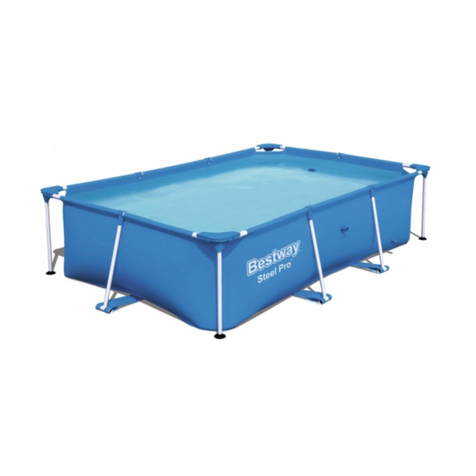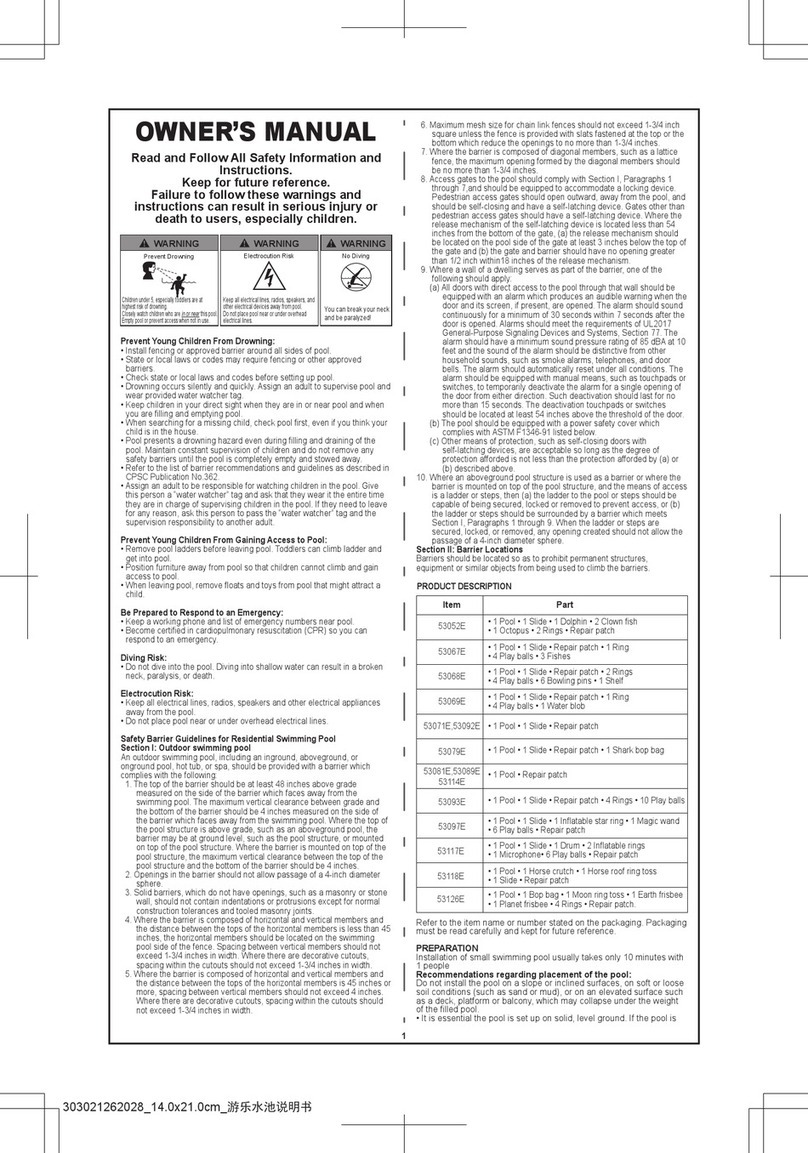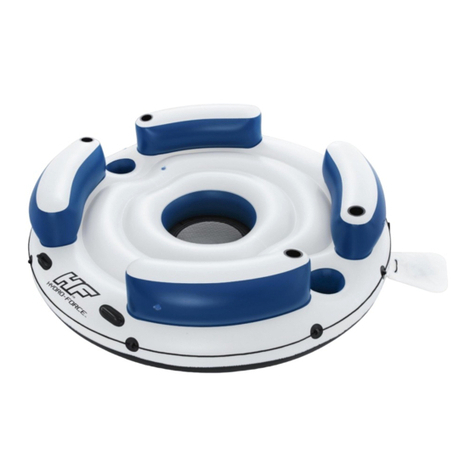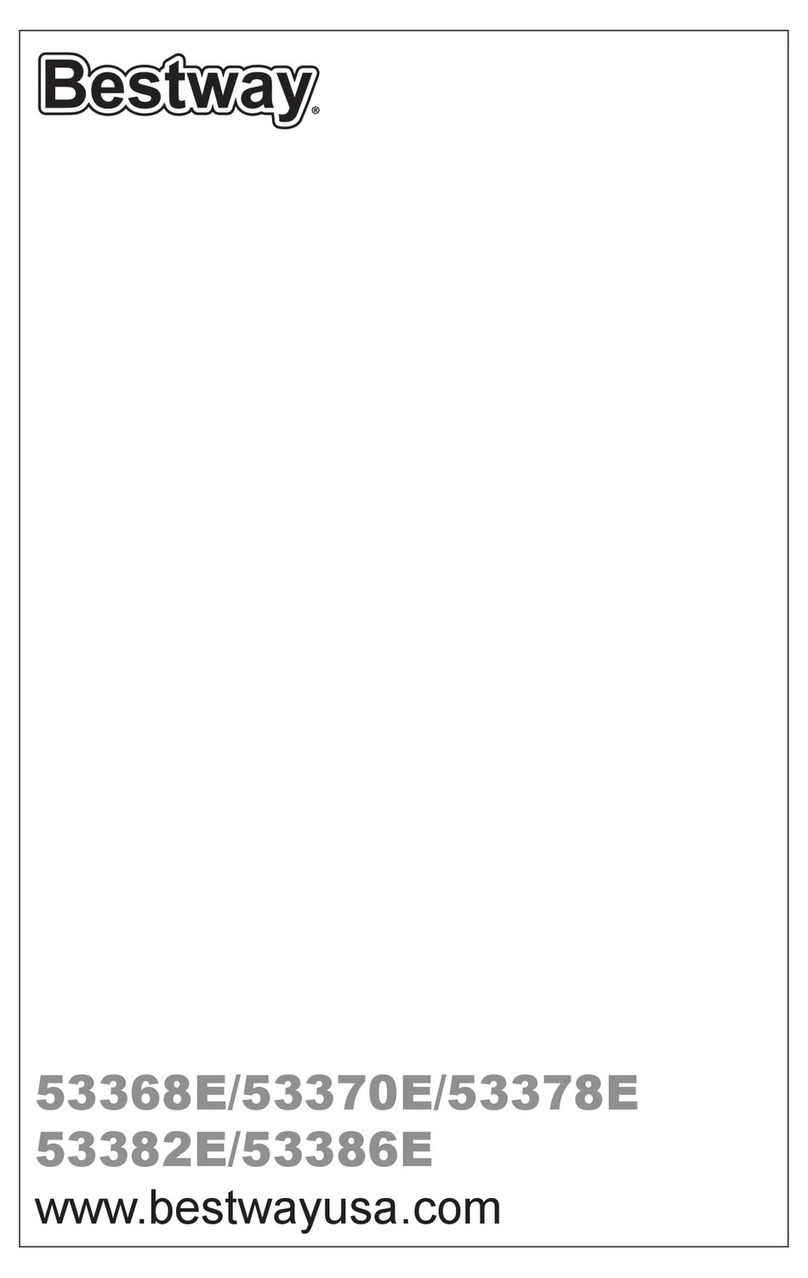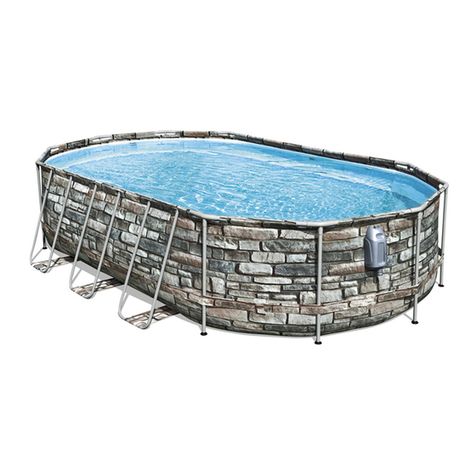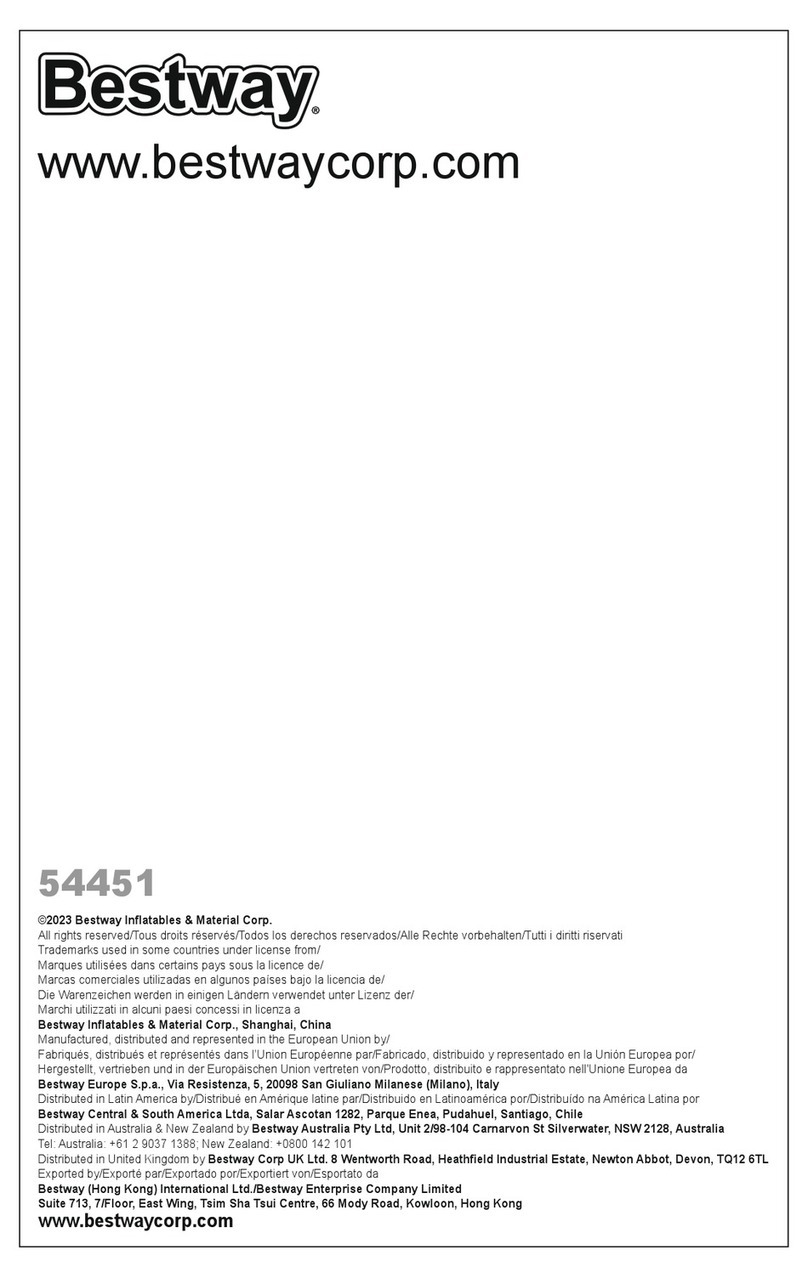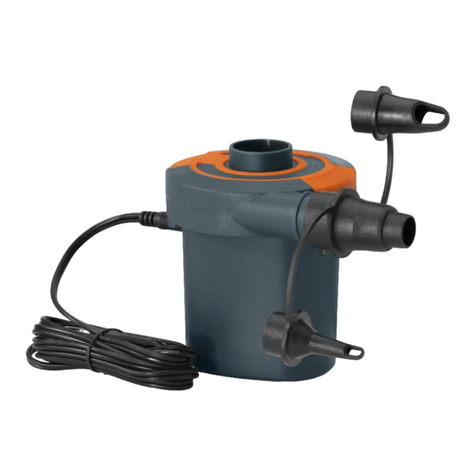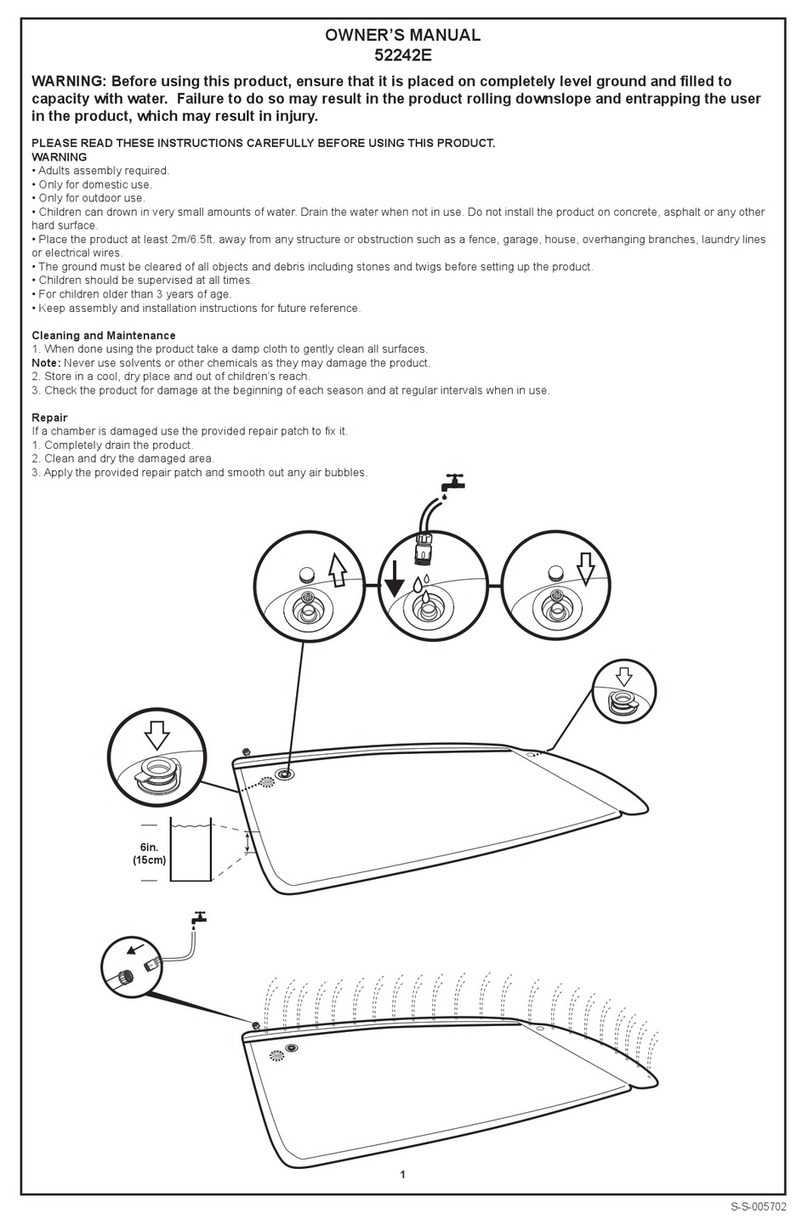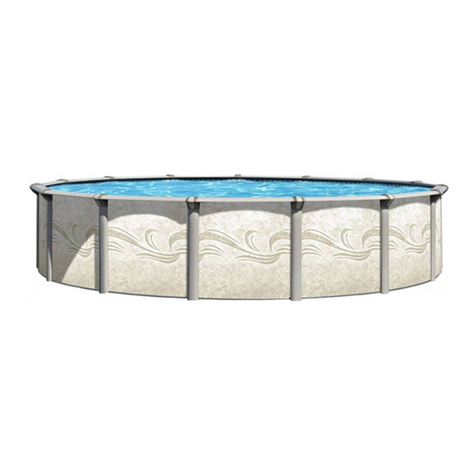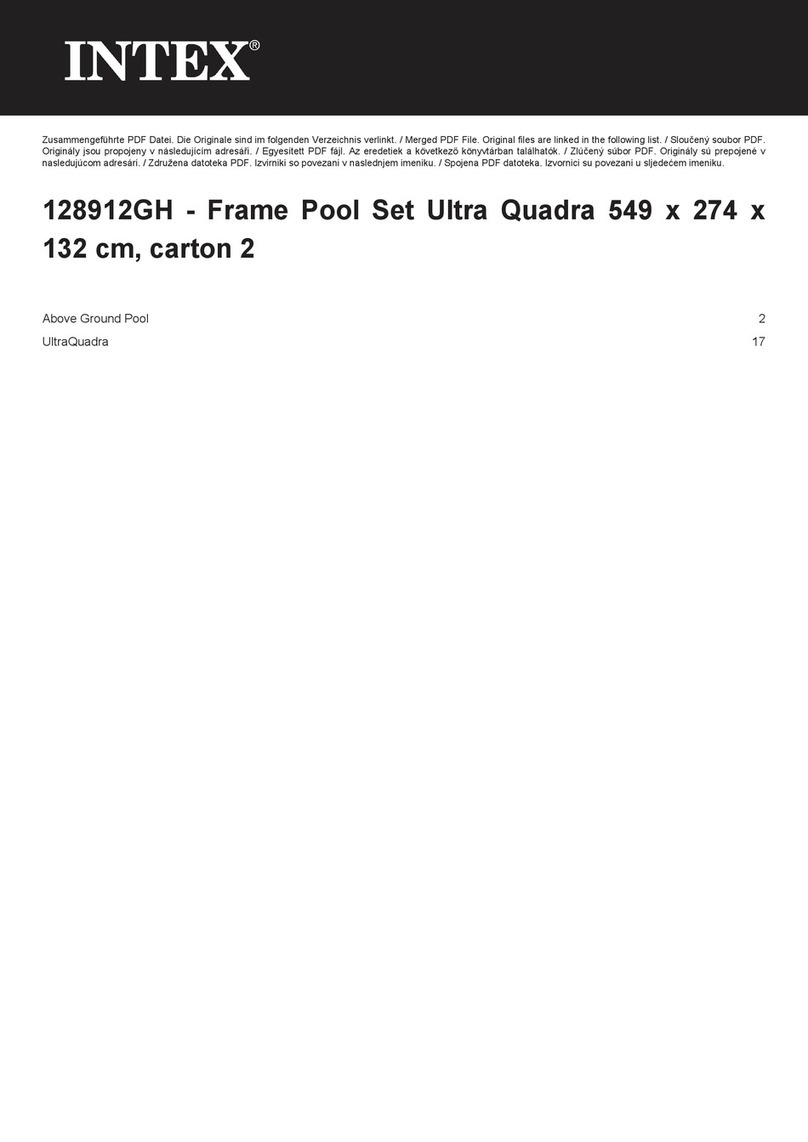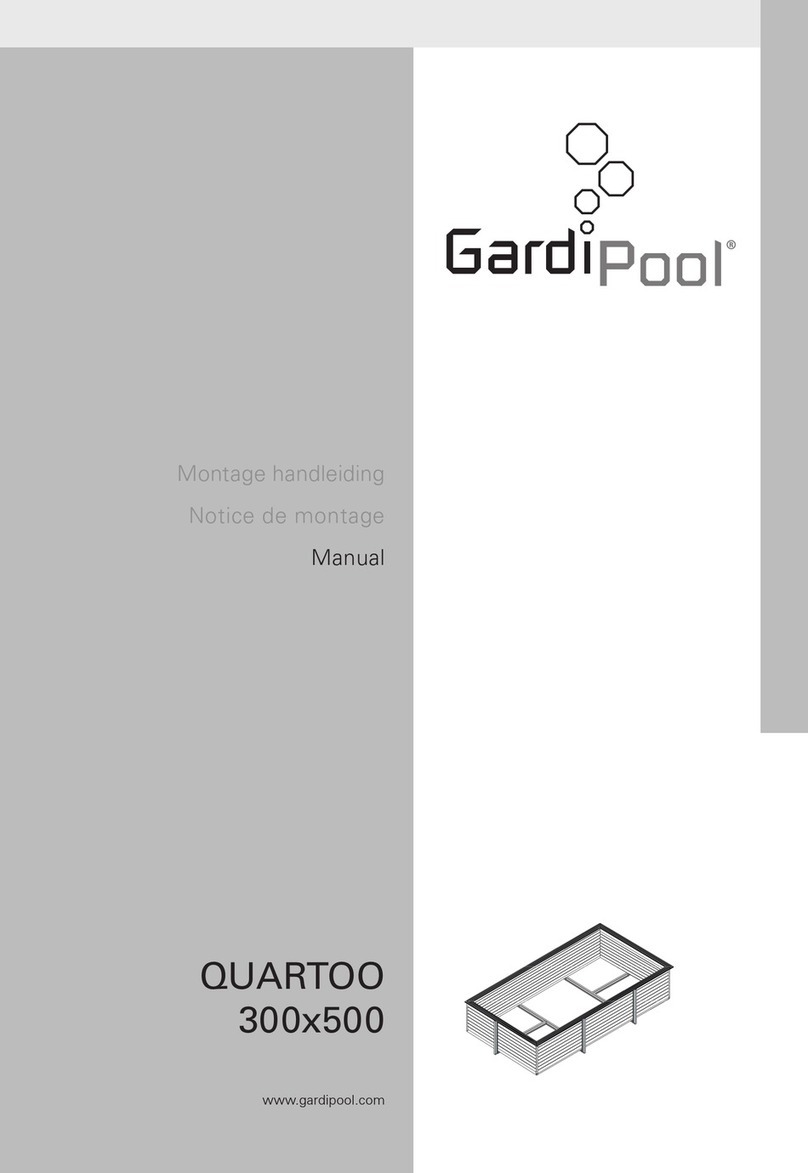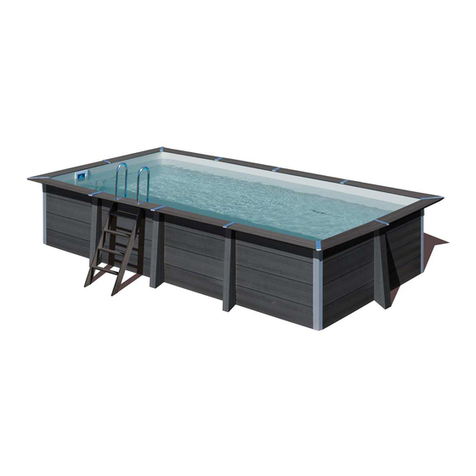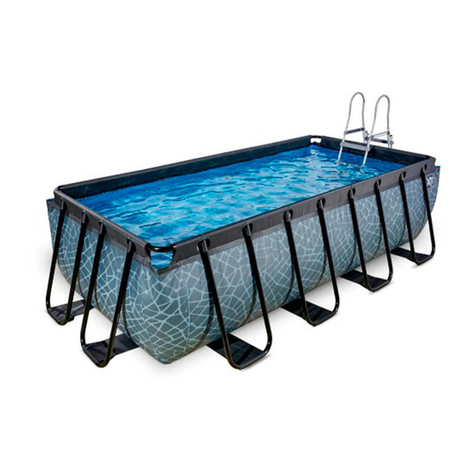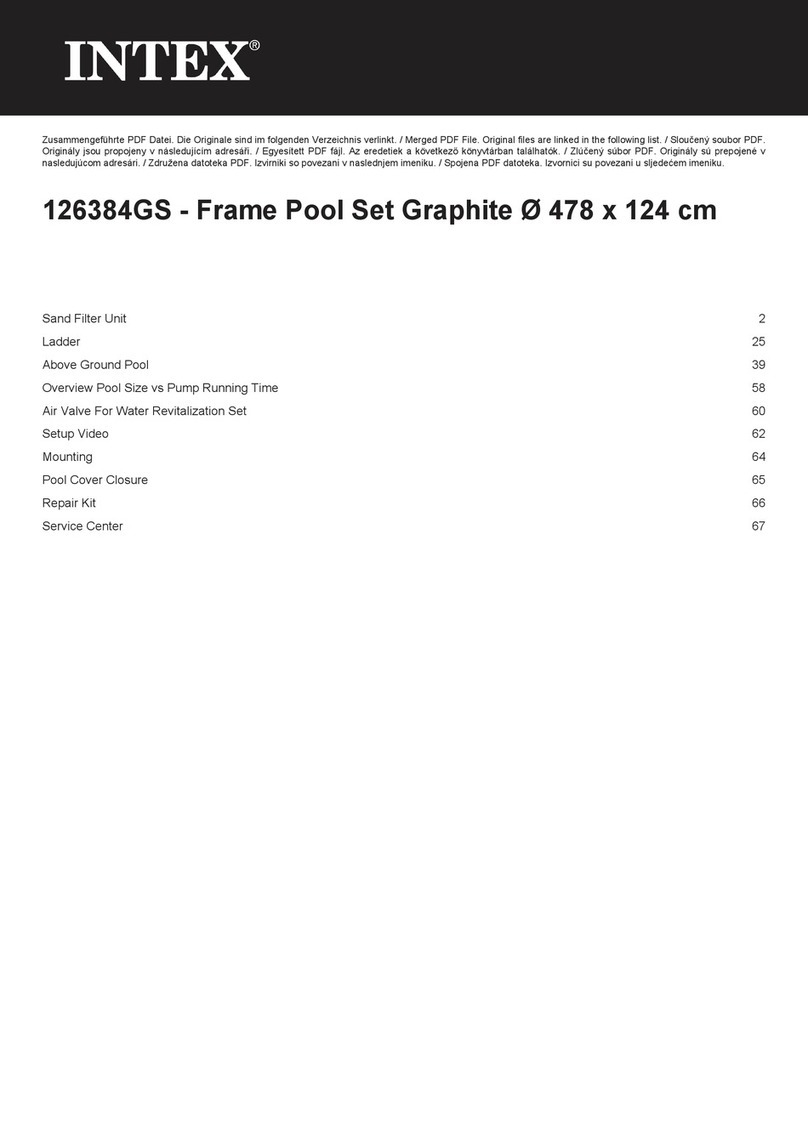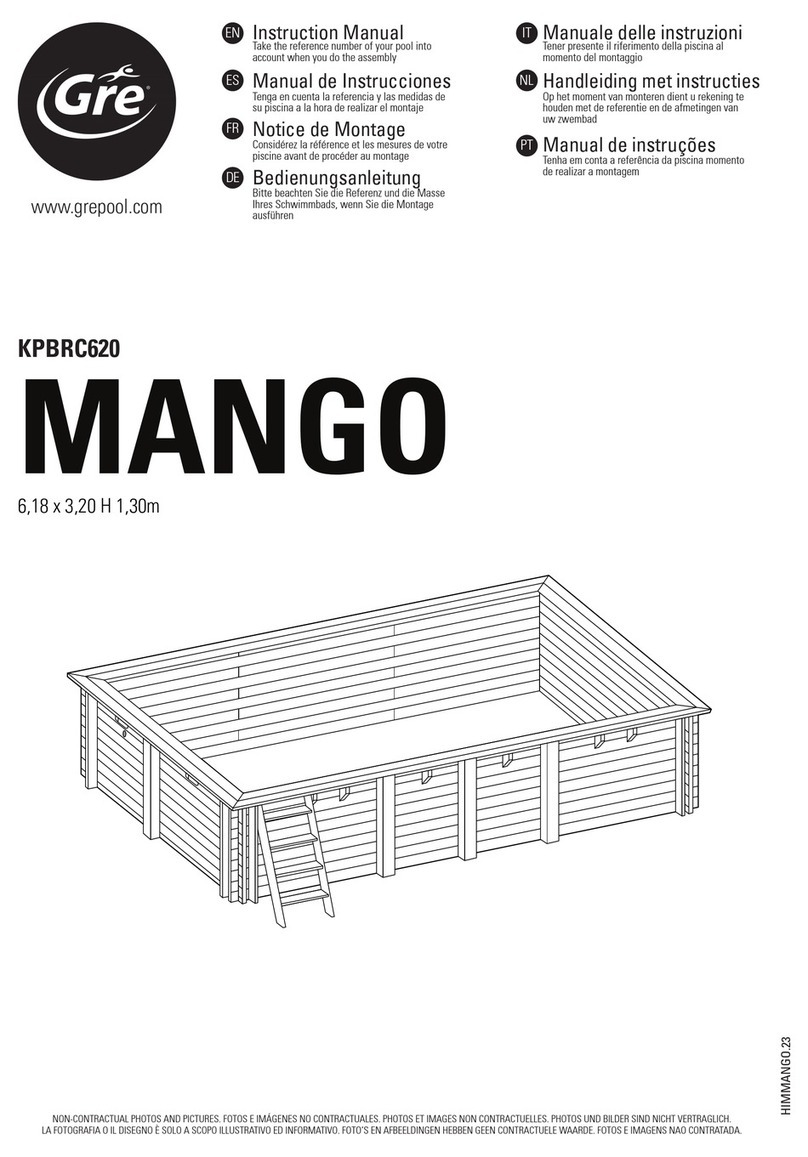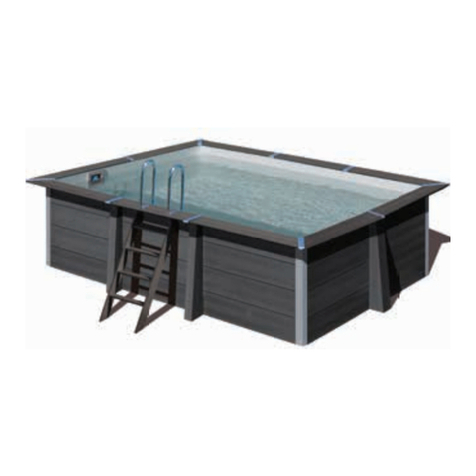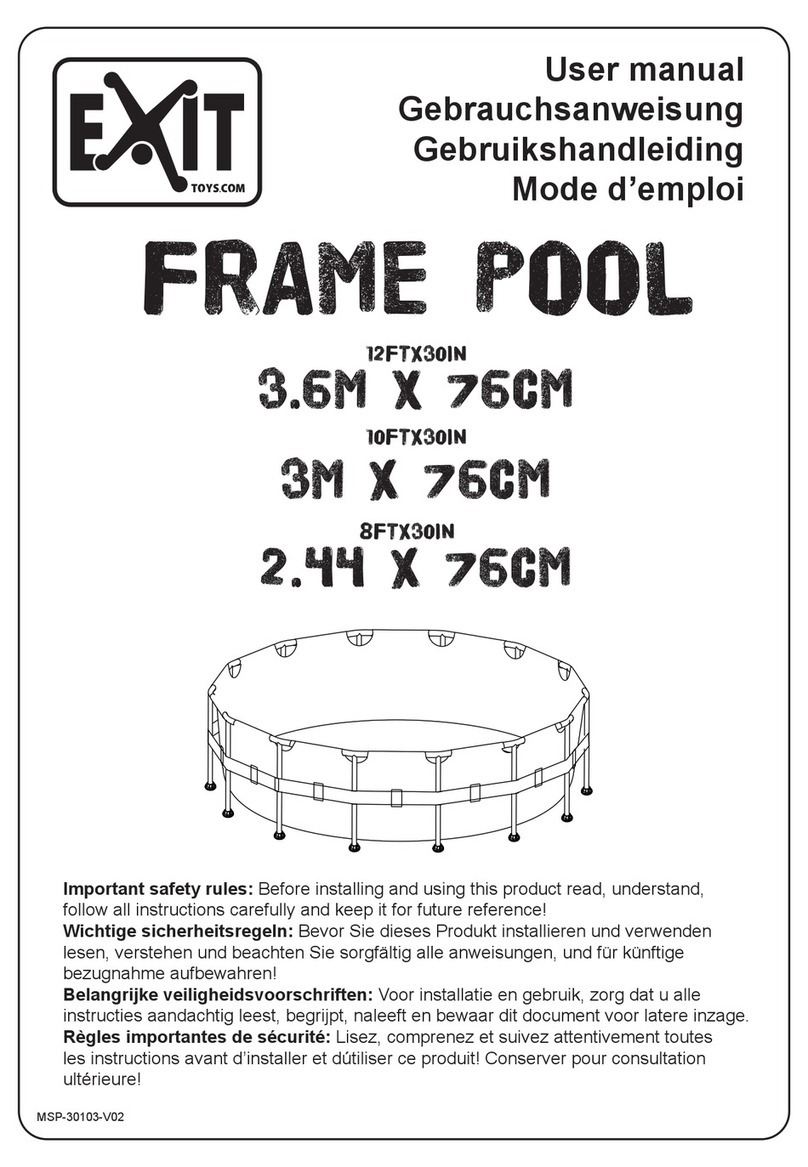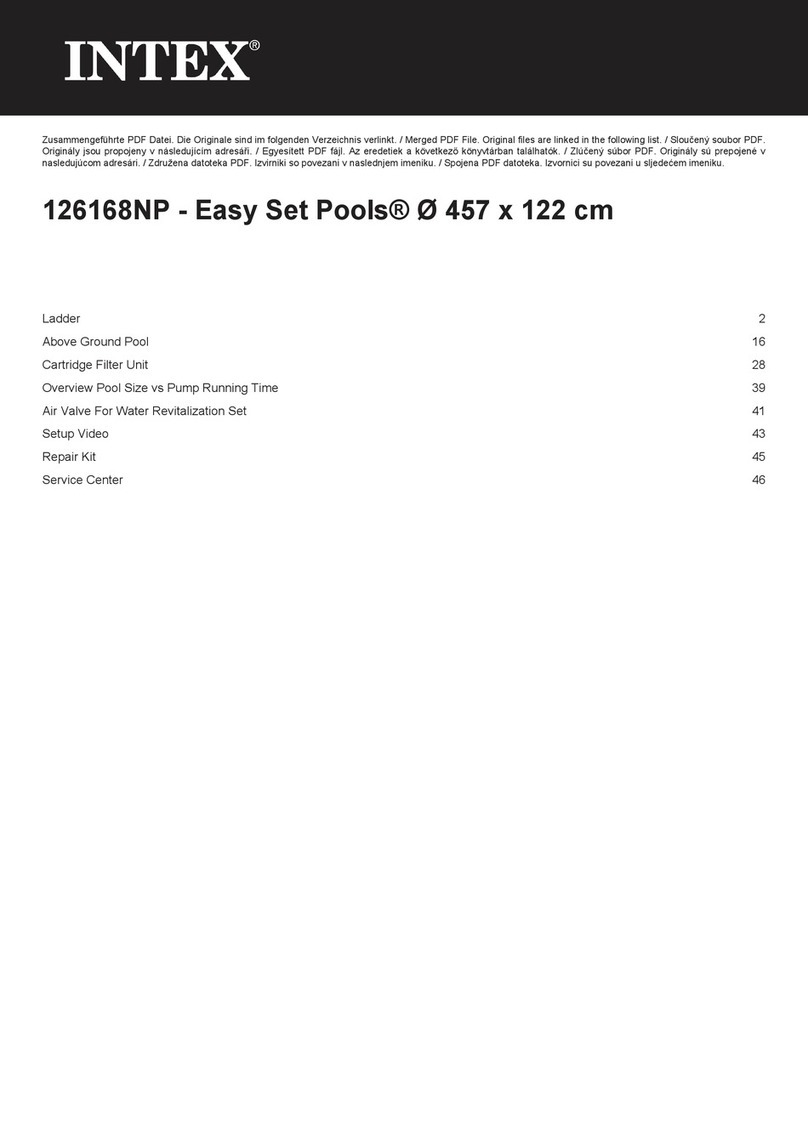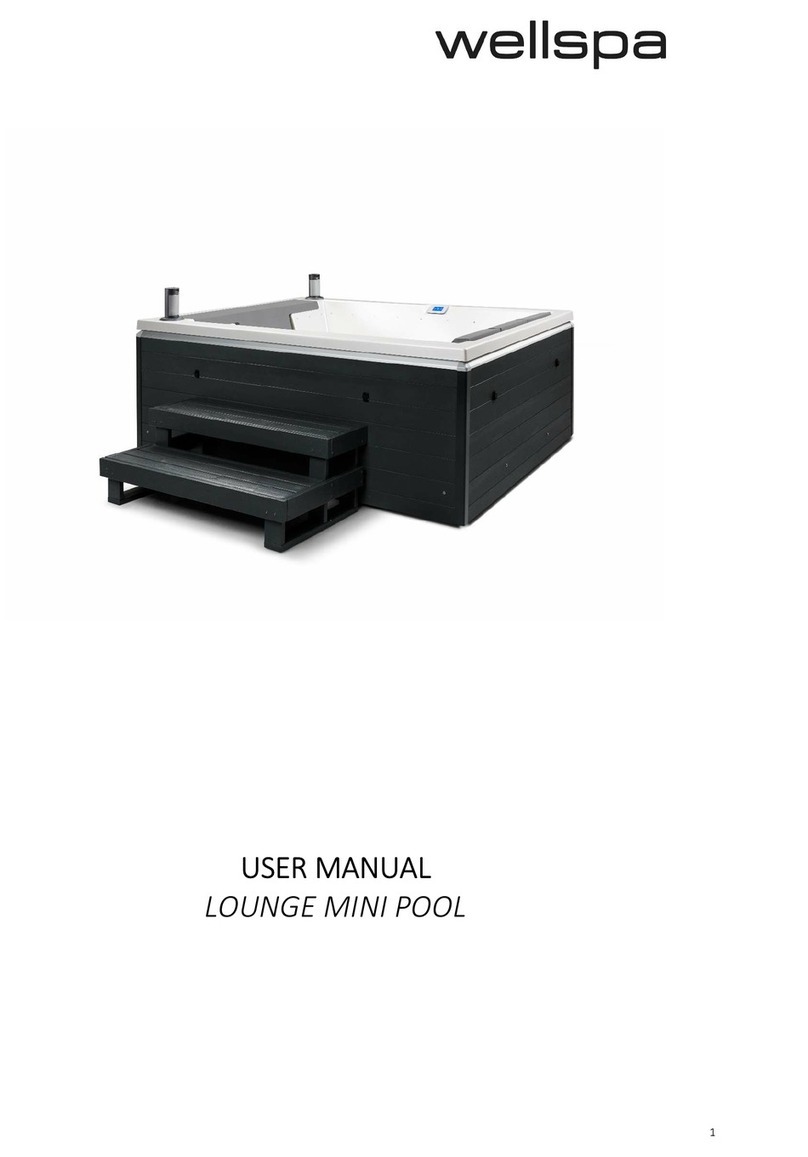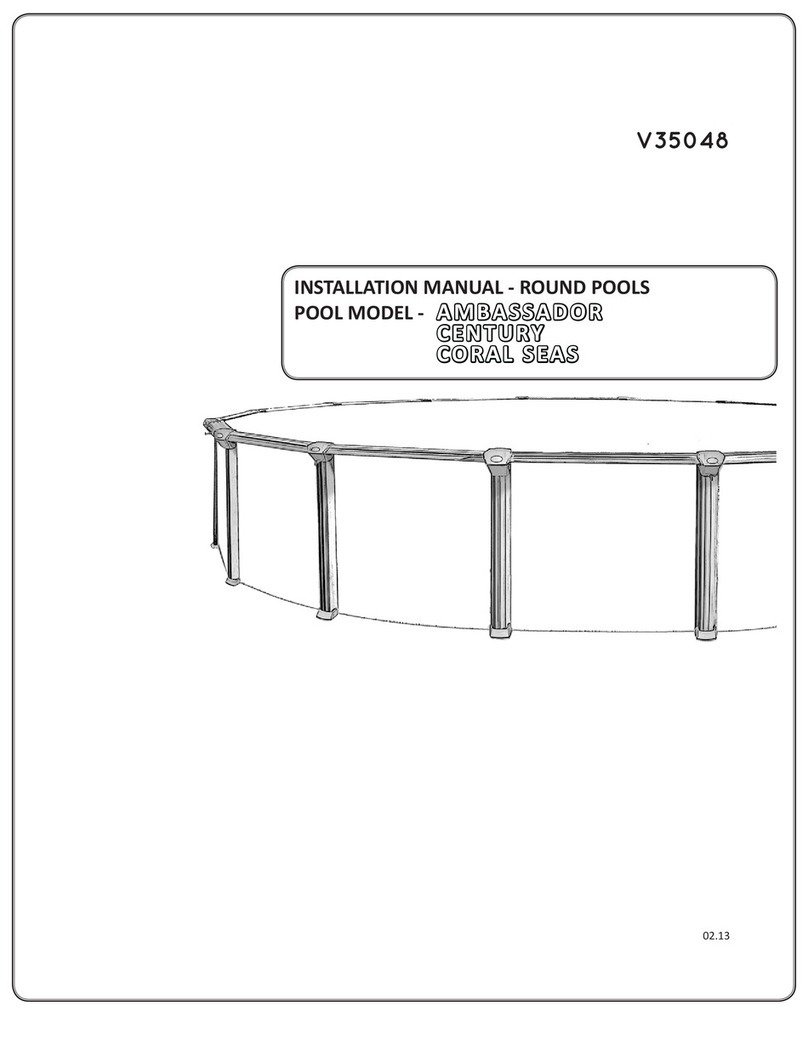
3
POOL MAINTENANCE
If you do not adhere to the maintenance guidelines below, your health might be at risk, especially that of your children.
Using chemical tablets (not included):
NOTE: Chemconnect or Chemical Floater must be used when you perform chemical maintenance with tablets. Your
purchased item may not include any of those dispensers, in this case you can purchase it by visiting our website
www.bestwaycorp.com or at the nearest pool dealer.
IMPORTANT: Don't use granulate tablets or throw the tablet directly in the water. The chemicals can deposit on the
bottom, damage the material and discolor the PVC.
Using chemical liquid (not included):
IMPORTANT: Add chemical liquid in small doses and in the center of the pool to avoid direct contact between the
chemicals and the PVC surface. Direct contact can damage the material and discolor the surface.
NOTE: Remove the chemical dispenser from pool when the pool is in use.
IMPORTANT: After performing chemical maintenance and before using the pool, use a test kit (not included) to test the
water chemistry. We recommend maintaining your water according to the following table.
NOTE: Damage resulting from chemical imbalance is not covered by the warranty. Pool chemicals are potentially toxic and
should be handled with care. There are serious health risks from chemical vapors and the incorrect labeling and storage of
chemical containers. Please consult your local pool supply retailer for more information about chemical maintenance. Pay
close attention to the chemical manufacturer's instructions. Pool damage resulting from misuse of chemicals and
mismanagement of pool water is not covered by the warranty.
IMPORTANT: Over usage of chemicals can discolor the printing and all points of the pool material. It can also damage the
structure of the pool liner.
To keep your pool clean:
1. Contact your local pool supply shop for advice and purchase of chemicals and pH kits. One of the most important
factors to increase the life of the liner is to keep continuously clean and healthy water. Please strictly follow the
instructions from professional technicians for the water treatment through the use of chemicals.
2. Locate a bucket of water next to pool to clean users’ feet before entering pool.
3. Cover the pool when not in use.
4. Skim pool regularly to avoid settled dirt.
5. Check and wash the filter cartridge regularly.
6. Gently clean any scum from below the top ring with a clean cloth.
7. Please be careful in case of rain water, kindly check that the water level is not higher than the expected. If so, YOU
HAVE TO DISCHARGE THE EXCESS WATER.
8. If it rains, check that the water level is not higher than the specified level. If water exceeds the specified levels, drain the
pool to the specified level.
Proper maintenance can maximize the life of your pool.
During the season of use of the swimming pool, the filtration system must be necessarily put into service every day,
enough time to assure at least a complete renewal of the volume of water.
NOTE: The pump is used to circulate the water and to filter small particles. In order to keep your pool water clean and
hygienic, you must also add chemicals.
REPAIR
In the event of a leak, patch your pool using the underwater adhesive repair patch provided. You can find the instructions in
FAQs on the support section of our website, www.bestwaycorp.com.
STORAGE
1. Please remove all the accessories and spare parts of the pool and store them clean and dry.
2. Store liner and accessories in a dry place with a moderate temperature between 5ºC / 41ºF and 38ºC / 100ºF.
3. During the rainy season, pool and accessories should be stored as per above instructions also.
4. Improper draining of the pool might cause serious personal injury and/or damage to personal property.
5. We strongly recommend the pool is disassembled during the off season (winter months). Store in a dry location out of
children’s reach.
If you do not want to dismantle the pool in winter, please observe the following instructions:
IMPORTANT: Do not drain all of the pool water. If you do so, the pool may be damaged by strong wind. Drain the water to
10cm below the inlet valve on the pool wall.
1. Drain the water to 10cm below the inlet valve on the pool wall. You can use a pump or a garden hose (Fig 33).
2. Treat the pool water with a suitable chemical product.
3. Remove the filtration system from the pool.
You can leave the inlets/outlets attached to the pool.
4. Also remove any other pool accessories and store them in a dry and cool place.
5. Protect the pool with the pool cover.
If you want to dismantle the pool in winter, please observe the following instructions:
1. Drain the pool with a garden hose, or use a drain pump to empty the pool (Fig 33).
2. Clean all pool parts with a sponge and soap with a neutral pH. Dry them and tidy them away in a dry and clean place.
Carefully read, understand, and follow all information in
this user manual before installing and using the swimming
pool. These warnings, instructions, and safety guidelines
address some common risks of water recreation, but they
cannot cover all risks and dangers in all cases. Always use
caution, common sense, and good judgment when
enjoying any water activity. Retain this information for
future use.
Non Swimmers safety
- Continuous, active, and vigilant supervision of weak
swimmers and non-swimmers by a competent adult is
required at all times (remembering that children under
five are at the highest risk of drowning).
- Designate a competent adult to supervise the pool each
time it is being used.
- Weak swimmers or non-swimmers should wear personal
protection equipment when using the pool.
- When the pool is not in use, or unsupervised, remove all
toys from the swimming pool and its surrounding to avoid
attracting children to the pool.
Safety devices
- In order to prevent children from drowning, it is
recommended to secure the access to the pool with a
protection device. In order to prevent children climbing
from the inlet and outlet valve, it is recommended to
install a barrier (and secure all doors and windows,
where applicable) to prevent unauthorized access to the
swimming pool.
- Barriers, pool covers, pool alarms, or similar safety
devices are helpful aids, but they are not substitutes for
continuous and competent adult supervision.
Safety equipment
- It is recommended to keep rescue equipment (e.g. a ring
buoy) by the pool.
- Keep a working phone and a list of emergency phone
numbers near the pool.
Safe use of the pool
- Encourage all users especially children to learn how to
swim.
- Learn Basic Life Support (Cardiopulmonary
Resuscitation - CPR) and refresh this knowledge
regularly. This can make a life-saving difference in the
event of an emergency.
- Instruct all pool users, including children, what to do in
case of an emergency.
- Never dive into any shallow body of water. This can lead
to serious injury or death.
- Do not use the swimming pool when using alcohol or
medication that may impair your ability to safely use the
pool.
- When pool covers are used, remove them completely
from the water surface before entering the pool.
- Protect pool occupants from water related illnesses by
keeping the pool water treated and practicing good
hygiene. Consult the water treatment guidelines in the
user’s manual.
- Store chemicals (e.g. water treatment, cleaning or
disinfection products) out of the reach of children.
- Use the signage as outlined below. Signage is to be
displayed in a prominent position within 2m of the pool.
- Keep children under supervision in the aquatic
environment. No diving.
- Removable ladders shall be placed on a horizontal
surface.
- Irrespective of materials used for swimming pool
construction, accessible surfaces have to be checked
regularly to avoid injuries.
- Regularly monitor bolts and screws; splinters or any
sharp edges to avoid injuries.
ATTENTION: Do not leave the drained pool outside. The
empty pool is liable to being deformed and/or displaced
due to wind.
- If have a filter pump, refer to the pump’s manual for
instructions.
WARNING!The pump cannot be used while people are
inside the pool!
- If have a ladder, refer to the ladder’s manual for
instructions.
WARNING! The use of a swimming pool implies
compliance with the safety instructions described in the
operating and maintenance guide. In order to prevent
drowning or other serious injuries, pay particular attention
to the possibility of unexpected access to the swimming
pool by children under 5 years by securing the access to
it, and, during the bathing period, keep them under
constant adult supervision.
Please read carefully and keep for future reference
WARNING
CHOOSE THE CORRECT LOCATION
The surface chosen to install the pool must respect the
following technical characteristics:
1. Because of the combined weight of the water inside the
pool and the pool users, it is extremely important that
the surface chosen to install the pool is capable of
uniformly supporting the total weight for the entire time
the pool is installed. When choosing the surface, take
into consideration that water may come out of the pool
when in use or in the rain. If the water softens the
surface, it may lose its capability to support the pool
weight.
2. We recommend positioning the pool away from any
objects children could use to climb into the pool.
3. Position the pool near an adequate drainage system to
deal with overflow or to discharge the pool.
4. The surface must be flat and smooth. If the surface is
inclined or uneven, it can create an unbalanced loading
on the structure of the pool. This situation can damage
the welding point of the liner, the steel wall top and the
vertical platforms. In the worst cases, the pool can
collapse, causing serious personal injury and/or
damage to personal property.
5. The selected surface must be clear of any type of
object. Due to the weight of the water, any object under
the pool could damage or perforate the bottom of the
pool.
6. The selected surface must be clear of aggressive plants
and weed species. Those types of strong vegetation
could grow through the liner and create water leakage.
The grass or other vegetation that may cause odor or
slime to develop have to be eliminated from the set-up
location.
7. The selected location must not have overhead power
lines or trees. Be sure the location does not contain
underground utility pipes, lines or cables of any kind.
8. The selected position must be far from house entrance.
Do not position any equipment or other furniture around
the pool. The water that comes out of the pool during
the use or due to a faulty product can damage the furniture inside the house or surrounding the pool.
9. The selected surface must be flat and without holes that can damage the material of the liner.
Follow the important instructions above to choose the correct surface and location to set up your pool. Damaged parts of
the pool, due to the fact that the set-up surface and location does not match the instructions, will not be considered as
manufacture defect and will avoid the warranty and any service claims.
Suggested set-up surfaces: grass, ground, concrete, and all other surfaces that respect the above set-up conditions.
Not suggested surfaces: mud, sand, gravel, deck, balcony, driveway, platform, soft/loose soil or other surface that does
not meet the above set-up conditions.
Check with your local city council for by-laws relating to fencing, barriers, lighting and safety requirements and ensure you
comply with all laws.
If have a filter pump, refer to the pump’s manual for instructions.
The ladder must match the pool size and should be used only for entering and exiting the pool. It is forbidden to exceed
the permitted payload of the ladder. Check regularly if the ladder is properly assembled.
